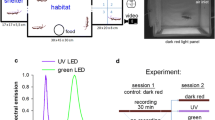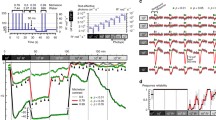Summary
-
1.
Under certain conditions Volvox is photopositive, under others, photonegative, and under still others it is neutral. If it is positive, a shadow on the photosensitive substance in the eyespots in the zooids causes change in the direction of the stroke of the flagella of the zooids from diagonal to backward and a flash of light on this substance causes change from diagonal to sidewise. If it is negative the reverse obtains and if it is neutral there is no response unless the changes in luminous intensity are great.
-
2.
The nature of the response to light in Volvox depends upon the state of adaptation and the intensity of the illumination. If it is fully adapted it becomes positive if the intensity is increased and negative if it is decreased. If it is not fully adapted, it becomes negative if the intensity is increased and positive if it is decreased.
-
3.
The time required for colonies of Volvox to become photopositive (reaction time) in illumination of a given intensity, after having been in strong light 1 to 2 hr., followed by darkness, increases to a maximum and then decreases as the time in darkness increases. If the colonies are kept longer in strong light and then subjected to darkness the reaction time decreases to a minimum and then increases as the time in darkness increases.
The time required for dark adaptation depends upon preceding illumination.
-
4.
The reaction time of dark adapted colonies is closely correlated with luminous intensity. As the intensity increases it decreases from 29 min. in 5/24 m. c. to a minimum of .098 min. in 7.5 m. c., and then increases to .358 min. in 62222 m. c. The energy required to make the colonies positive varies directly with the luminous intensity over the whole range tested and over most of the range the variation is nearly proportional to the variation in intensity.
-
5.
If colonies are kept in a given intensity or in darkness they become adapted, i. e. they lose the ability to respond to light and if the intensity is now changed they regain it. If dark adapted colonies are exposed to light of 22400 m. c. for .05 min., then returned to darkness, it takes about 20 min. in darkness to eliminate the effect of the light. If they are left in the light .15 min. it takes about 30 min. The processes associated with adaptation and those induced by change in illumination are antagonistic.
-
6.
To account for the responses to light in Volvox, it is necessary to postulate at least three groups of interacting substances.
Similar content being viewed by others
Literature cited
Mast, S. O.: Light reactions in lower organisms. II. Volvox. J. comp. Neur. a. Psychol. 17, 99–180 (1907).
—: Reversal in the sense of orientation to light in the colonial forms, Volvox globator and Pandorina moram. J. of exper. Zool. 27, 367–390 (1919).
—: Reversal in photic orientation in Volvox and the nature of photic stimulation. Z. vergl. Physiol. 5, 730–738 (1927).
Luntz, A.: Untersuchungen über die Phototaxis. III. Mitt.: Die Umkehr der Reaktionsrichtung bei starken Lichtintensitäten und ihre Bedeutung für eine allgemeine Theorie der photischen Reizwirkung. Ebenda 16, 204–217 (1932).
Author information
Authors and Affiliations
Rights and permissions
About this article
Cite this article
Mast, S.O. The rate of adaptation to light and to darkness in Volvox globator . Z. f. vergl. Physiologie 17, 644–658 (1932). https://doi.org/10.1007/BF00340895
Received:
Issue Date:
DOI: https://doi.org/10.1007/BF00340895




